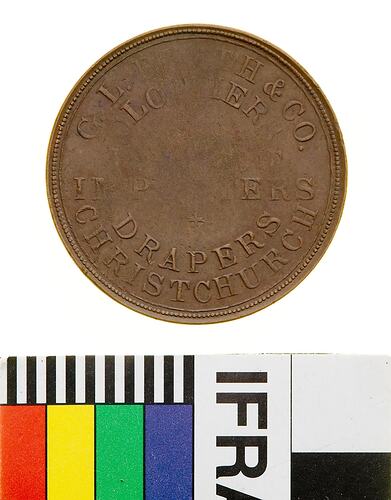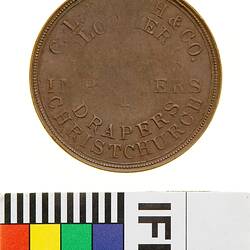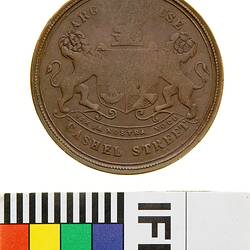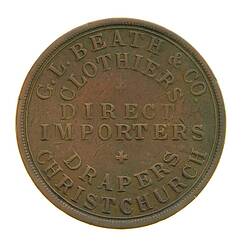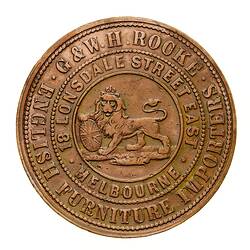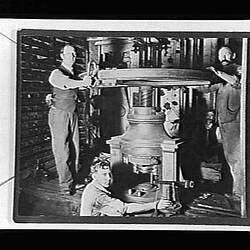Summary
Bronze One Penny Token, minted by Stokes, Melbourne. Issued by G.L. Beath & Co, Drapers, Christchurch, circa 1870. G.L. Beath & Co. was actually founded by a Mr. Kirby in 1860, and Beath only joined the company in 1866. Kirby later left the business, and Beath brought in his brother-in-law, Frank Malcolm. Beath and Malcolm remained in business together until 1896, trading as G.L. Beath & Co. Malcolm left the partnership in 1896 to go into business on his own and Beath was joined by J.E. Wickenden. Together they expanded their store greatly, and in 1902 they transformed the business into a limited liability company. By this time Beath had retired from active involvement in the business, but he remained a director of the company until his death in 1914.
Physical Description
A round copper token (31 mm diameter). The piece features the name, address and business of the issuer: G.L Beath & Co., Argile House, Cashel Street, Christchurch, importers, clothiers and drapers. The reverse features a coat of arms with lion supporters. This token was very weakly struck.
Obverse Description
Legend in seven lines, G.L. BEATH & CO / CLOTHIERS / DIRECT / IMPORTERS / & / DRAPERS / CHRISTCHURCH
Reverse Description
At centre a coat of arms with lion supporters. Around, ARGYLE HOUSE CASHEL STREET Motto on ribbon below arms, VIX EA NOSTRA VOCO
Edge Description
Plain
More Information
-
Collection Names
-
Collecting Areas
Clothing & Textiles, Numismatics & Philately, Working Life & Trades
-
Acquisition Information
Transfer from National Gallery of Victoria (NGV), Mr Alfred Chitty, 15 Mar 1976
-
Date Issued
circa 1870 AD
-
Issued By
Beath, G.L. & Co. Drapers, Christchurch, Canterbury, South Island, New Zealand, circa 1870
-
Mint
Stokes (Mint), Melbourne, Greater Melbourne, Victoria, Australia, circa 1870
-
Previous Collection
-
Inscriptions
Obverse: G.L. BEATH & CO CLOTHIERS DIRECT IMPORTERS & DRAPERS CHRISTCHURCH Reverse: ARGYLE HOUSE CASHEL STREET VIX EA NOSTRA VOCO
-
Denomination
-
Series
-
Material
Bronze
-
Axis
12
-
Classification
-
Category
-
Discipline
-
Type of item
-
Dimensions
31 mm (Outside Diameter), 9.575 g (Weight)
-
Shape
Round
-
References
Stokes needed four obverse and two reverse dies to complete this order for penny tokens. Identification of the die combination employed to strike a particular token is the basis of standard reference and the museum storage system. Stokes appear to have used whatever copper based metal they coul find to strike these tokesn, copper, brass and bronze are found in most die combinations. Andrews gave different reference numbers to different metals and this led to early collectors cleaning the tokens to try to ascertain which Andrews references they had and lacked. This system is not followed here. The dies can be differentiated by: Obverse Symbol I of CLOTHIERS A quotrofoil below T B cross between TH C cross below H D cross below T Reverse A of ARGYLE Last T of STREET to lion foot 1 re-entered & touches mane 0.5 mm 2 does not touch mane 2.0 mm
[Book] Andrews, Arthur. 1921. Australasian Tokens and Coins., No. 40
[Book] Heyde, Gilbert C. & Skinner, Dion H. 1967. Unofficial Coins of Colonial Australia and New Zealand., No. 23/2
[Book] Lampard, William H. 1981. Catalogue of New Zealand Coins Tokens Bank Notes., No. 306a
[Book] Humberstone, Vaughn. 2010. Merchants Making Money.
-
Keywords
Clothing Trade, Drapers, Import Trade, Retail Trade, Retailing
